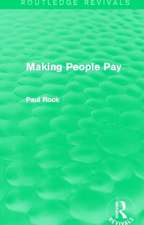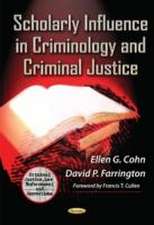Crime and Deviance in Cyberspace: International Library of Criminology, Criminal Justice and Penology - Second Series
Editat de David S. Wallen Limba Engleză Hardback – 5 aug 2009
Din seria International Library of Criminology, Criminal Justice and Penology - Second Series
- 26%
 Preț: 1832.54 lei
Preț: 1832.54 lei - 25%
 Preț: 997.68 lei
Preț: 997.68 lei -
 Preț: 414.36 lei
Preț: 414.36 lei - 25%
 Preț: 1107.09 lei
Preț: 1107.09 lei - 24%
 Preț: 1135.95 lei
Preț: 1135.95 lei - 26%
 Preț: 1634.02 lei
Preț: 1634.02 lei - 26%
 Preț: 1635.96 lei
Preț: 1635.96 lei - 26%
 Preț: 1819.09 lei
Preț: 1819.09 lei - 25%
 Preț: 939.94 lei
Preț: 939.94 lei - 26%
 Preț: 1832.12 lei
Preț: 1832.12 lei - 25%
 Preț: 1724.07 lei
Preț: 1724.07 lei - 26%
 Preț: 1695.20 lei
Preț: 1695.20 lei - 26%
 Preț: 1695.20 lei
Preț: 1695.20 lei - 25%
 Preț: 995.15 lei
Preț: 995.15 lei - 19%
 Preț: 468.02 lei
Preț: 468.02 lei - 26%
 Preț: 1640.85 lei
Preț: 1640.85 lei
Preț: 1830.35 lei
Preț vechi: 2465.88 lei
-26% Nou
Puncte Express: 2746
Preț estimativ în valută:
350.40€ • 364.23$ • 290.52£
350.40€ • 364.23$ • 290.52£
Carte tipărită la comandă
Livrare economică 06-20 februarie 25
Preluare comenzi: 021 569.72.76
Specificații
ISBN-13: 9780754624530
ISBN-10: 0754624536
Pagini: 624
Dimensiuni: 169 x 244 mm
Greutate: 1.08 kg
Ediția:1
Editura: Taylor & Francis
Colecția Routledge
Seria International Library of Criminology, Criminal Justice and Penology - Second Series
Locul publicării:Oxford, United Kingdom
ISBN-10: 0754624536
Pagini: 624
Dimensiuni: 169 x 244 mm
Greutate: 1.08 kg
Ediția:1
Editura: Taylor & Francis
Colecția Routledge
Seria International Library of Criminology, Criminal Justice and Penology - Second Series
Locul publicării:Oxford, United Kingdom
Cuprins
Contents: Introduction; Part I Developments in Thinking About Cybercrimes: The novelty of 'cybercrime': an assessment in light of routine activity theory, Majid Yar; The criminology of hybrids: rethinking crime and law in technosocial networks, Sheila Brown. Part II Changes in the Organization of Crime Online: Organized cybercrime? How cyberspace may affect the structure of criminal relationships, Susan W. Brenner; Digital realism and the governance of spam as cybercrime, David S. Wall; Can the law can spam? Legislation is a blunt instrument with which to beat junk email, Sandy Starr; Can technology can spam? IT companies do battle with bulk email, Sandy Starr; Viruses, worms and Trojan horses: serious crimes, nuisance, or both?, Lorine A. Hughes and Gregory J. DeLone; Policing diversity in the digital age: maintaining order in virtual communities, David S. Wall and Matthew Williams. Part III The Changing Nature of Cybercrime: Computer Integrity Crime: Hackers and the contested ontology of cyberspace, Helen Nissenbaum; The internet in the aftermath of the World Trade Center attack, Briavel Holcombe, Philip B. Bakelaar and Mark Zizzamia; Computer Assisted Crime: Cross-national investigation and prosecution of intellectual property crimes: the operation of 'Operation Buccaneer', Gregor Urbas; Identity theft, identity fraud and /or identity-related crime. Definitions matter, Bert-Jaap Koops and Ronald Leenes; Computer Content Crime: International police operations against online child pornography, Tony Krone; Fetishising images, Barbara Hewson; Now you see it, now you don’t: digital images and the meaning of 'possession', Jonathan Clough; Cyberstalking and cyberpredators: a threat to safe sexuality on the internet, Francesca Philips and Gabrielle Morrissey; The social construction of digital danger: debating, defusing and inflating the moral dangers of online humor and pornography in the Netherlands and the United States, Giselinde Kuipers; Hiding in plain sight: an
Notă biografică
David S. Wall is the Director of the Centre for Criminal Justice Studies in the Department of Law at the University of Leeds, UK.
Descriere
The increase in internet service delivery speeds from 56kb to 56mb per second combined with greater accessibility to digital environments helped give birth to a completely new generation of purely internet-related cybercrimes. The articles in this volume cover the years of change 2002-2007, and examine spamming, phishing and other automated frauds, as well as automated crimes against the integrity of the systems and their content.






















